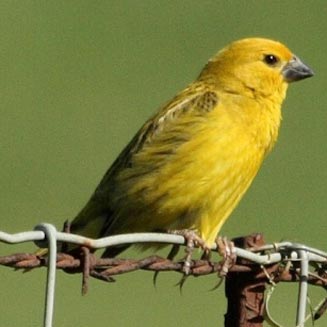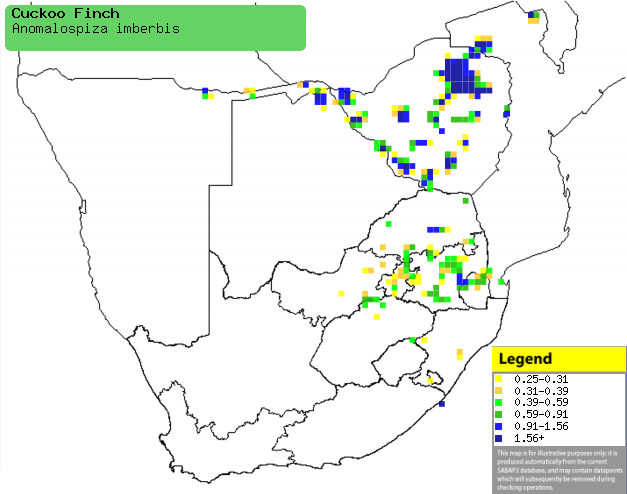|
Anomalospiza imberbis (Cuckoo
finch)
Koekoekvink [Afrikaans]; Koekoekswever [Dutch];
Anomalospize parasite [French]; Kuckucksweber [German]; Tecel„o-parasita
[Portuguese]
Life
> Eukaryotes >
Opisthokonta
> Metazoa (animals) >
Bilateria >
Deuterostomia > Chordata >
Craniata > Vertebrata (vertebrates) > Gnathostomata (jawed
vertebrates) > Teleostomi (teleost fish) > Osteichthyes (bony fish) > Class:
Sarcopterygii (lobe-finned
fish) > Stegocephalia (terrestrial
vertebrates) > Tetrapoda
(four-legged vertebrates) > Reptiliomorpha > Amniota >
Reptilia (reptiles) >
Romeriida > Diapsida > Archosauromorpha > Archosauria >
Dinosauria
(dinosaurs) > Saurischia > Theropoda (bipedal predatory dinosaurs) >
Coelurosauria > Maniraptora > Aves
(birds) >
Order: Passeriformes > Family: Viduidae
 |
|
|
Cuckoo finch, Midmar Game Reserve, KwaZulu-Natal,
South Africa. [photo
Alan Manson
©] |
|
For information about this species, see
www.birdforum.net/opus/Parasitic_Weaver
Distribution and habitat
Occurs in patches across Africa's western coast from Guinea
to Cameroon, with a separate population extending from Ethiopia through
Tanzania, Zambia and Angola to southern Africa. Here it is uncommon in
Swaziland, Mpumalanga and surrounding provinces, while more common across
Zimbabwe and northern Mozambique, extending into northern Botswana and the
Caprivi Strip (Namibia). It generally prefers open or lightly wooded grasslands,
grassy vleis, flood plains, cultivated areas such as rice paddies and pastures,
airfields and old cotton fields.
|
 |
|
Distribution of Cuckoo finch in southern Africa,
based on statistical smoothing of the records from first SA Bird Atlas
Project (©
Animal Demography unit, University of
Cape Town; smoothing by Birgit Erni and Francesca Little). Colours range
from dark blue (most common) through to yellow (least common).
See here for the latest distribution
from the SABAP2. |
Movements and migrations
It can be resident, nomadic or migratory,
moving in flocks of usually 8-50, but sometimes over 1000 birds, all
looking for areas which have experienced recent rainfall.
Food
It mainly eats grass seeds taken directly from plants or
plucked from the ground, rarely eating insects. The following food items have been recorded
in its diet:
- Seeds
- grass
- Setaria sphacelata (Golden bristle grass)
- Scirpus (sedges)
- Helianthus (sunflowers)
- Insects
Breeding
- It is a brood parasite, laying its eggs in other birds nests, especially
the following species:
- Cisticola (cisticolas)
- Prinia (prinias)
- Egg-laying season is from September-April, peaking from
December-February.
- The female first removes one or all of the host's eggs before laying a
single egg (usually parasitising four nests in the space of a few days),
with a total of about 30 eggs laid in each breeding season. The egg usually
hatches after about 14 days of incubation.
- The chick is usually fed on a diet of insects, leaving the nest after
about 18 days. It starts to forage about 10 days after fledging, but it
remains under the care of its host for several weeks longer before leaving
to join a flock of the same species.
Threats
Not threatened.
References
-
Hockey PAR, Dean WRJ and Ryan PG 2005. Roberts
- Birds of southern Africa, VIIth ed. The Trustees of the John Voelcker
Bird Book Fund, Cape Town.
|
